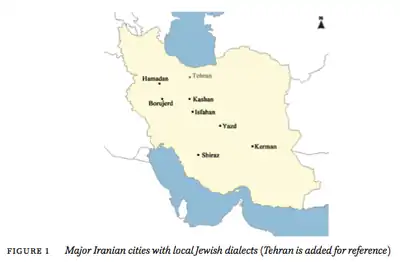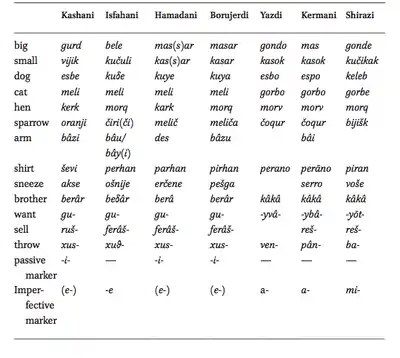Judeo-Hamedani–Borujerdi
Judeo-Hamadani and Judeo-Borujerdi constitute a Northwestern Iranian language, originally spoken by the Iranian Jews of Hamadan and Borujerd in western Iran.[1]
In 1920, Hamadan had around 13,000 Jewish residents. According to members of the community that Donald Stilo encountered in 2001-02, there were only eight people from the Jewish community left in Hamadān at the time, but others can still be found in Israel, New York City, and most predominantly in Los Angeles.
| Judeo-Hamadani Judeo-Borujerdi | |
|---|---|
| Judeo-Persian | |
| Native to | Iran |
Native speakers | 8 of Judeo-Hamadani (2001) |
Indo-European
| |
| Hebrew script | |
| Language codes | |
| ISO 639-3 | – |
| Glottolog | jude1268 |
| ELP | Judeo-Hamadani |
Judeo-Hamedani Classification

In western Iran, the district of Hamadan is split between Tuyserkan, Malayer, and Nahavand. This district along with Borujerd, further[3] south in Lorestan Province, forms a geographic cluster that was inhabited by a good portion of Iranian-Jewish communities until recently when those communities emigrated to Tehran, Israel, and North America. Already in 1701, Paul Lucas (cited by De Planhol 2003) wrote that Jews were more numerous in Hamadan than elsewhere in Persia. According to Encyclopedia Iranica, the Jewish community had dwindled from around 13,000 souls in 1920 to less than 1,000 by 1969.[4] It explains that according to members of the community that Donald Stilo encountered in 2001-02, there were only eight people from the Jewish community left in Hamadan at the time. It is hard to find people who still speak the Judeo-Hamadani language since only people born before the mid-1940s were raised speaking the dialect. As Habib Borjian points out, Hamadan was once the capital of Media, implying that a form of Median must have been spoken here before the arrival of Persian (Habib Borjian, 121).[3] Habib Borjian explains that these moribund dialects show closest resemblance to the dialects spoken in the areas of Qazvin and Zanjan, both north of Hamadan, and further northwest in Azerbaijan (Habib Borjian, 121). However, if we look at the historical arrangement of Jewish dialects of Hamadan, we see that they waere originally native only to central Iran. This leads to the implication that only population movements from central Iran could have occasioned the presence of the Jewish dialects in the Hamadan area.
Judeo-Hamedani Grammar

If we look at the chart below, we can see how Judeo-Hamadani is compared to some of the other Judeo-Median Languages. We find it similar with Kashani, when it comes to passive and imperfective markers. We also find it united with Isfahani and Kashani with throw, want, and cat. With comparison to Isfahani, Judeo-Hamadani is similar with respects to dog. Within the same list we find Hamadani and Borujerdi further share the word sparrow. In terms of morphosyntax, although Hamadani is most similar to Kashani and Isfahani, the differences are sufficient to make mutual understanding quite low. According to Habib Borjian, “Tentative studies reveal that Tuyserkani agrees with Hamadani in all major grammatical points and lexical items (Stilo 2003), and that the dialects of Borujerd and Nehavand15 are close (Yarshater 1989)” (Borjian, 130).
References
- Gholami, Saloumeh (January 2022). Siavoshi, Sussan (ed.). "Judeo-Hamadani: The Language of Jews in Hamadan and Its Origins". Iranian Studies. Cambridge and New York: Cambridge University Press on behalf of the Association for Iranian Studies. 54 (5–6): 769–805. doi:10.1080/00210862.2020.1848420. ISSN 1475-4819. LCCN sn85060395. OCLC 1753915. S2CID 234006069.
- Borjian, Habib (2014). "What is Judeo-Median and how does it differ from Judeo-Persian?". The Journal of Jewish Languages.
- Borjian, Habib (2014). "What is Judeo-Median and how does it differ from Judeo-Persian?". Journal of Jewish languages.
- "Hamadan".
Further reading
- Gholami, Saloumeh (2021). "Judeo-Hamadani: The Language of Jews in Hamadan and Its Origins". Iranian Studies. doi:10.1080/00210862.2020.1848420.